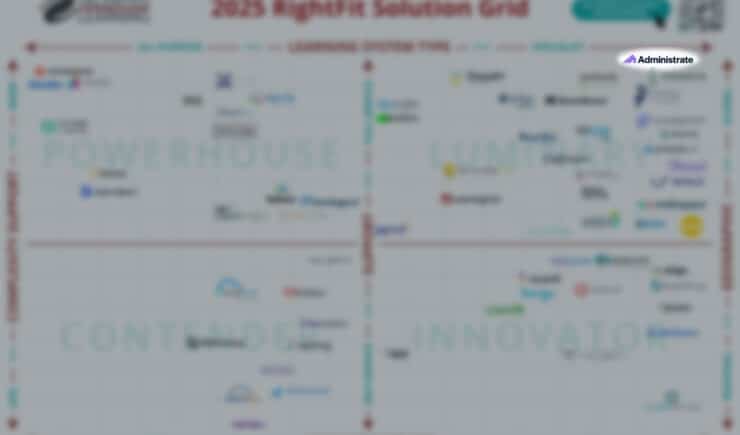How Administrate Scales Your Effort and Maximizes Resources
Scaling Training Operations in Administrate
This blog is part of the How to Align Training Needs with Business Outcomes blog and video series. In this article, we explore how a training management platform allows training teams to scale their programs to address changing organizational goals and challenges. Check out the video below to see how Administrate can scale your program.
Imagine this: you’ve been emailing a colleague in Human Resources for a week to get the latest list of new managers. You need the list so you can parse it – a fairly manual process you do in a spreadsheet – to see if any new managers meet requirements for a new ethics course. The course, developed in conjunction with the legal and compliance team, addresses laws that apply to several of your field offices but not everywhere. In fact, there could be some legal snafus if you required all managers to take this course.
You send one more email reminder – a response comes back instantly. Your heart sinks. It’s an out of office auto reply. With a holistic learning tech Infrastructure, training data is connected with other critical business systems to prevent this sort of bottleneck, caused by siloed systems. In this example, all cross-functional information needed to enroll managers into the ethics course would be available in Administrate – automatically. By connecting to HRIS data, Administrate could update learner records when they were promoted.
Watch the Video: Scale Training Operations
Learning technology is typically designed to solve a single problem: delivery in one modality of training, communication with one segment of your program, learner registration, content creation. This creates a learning tech stack that is not well connected and plagued with the problems that arise from siloed software: reports that don’t tell the same story, a growing number of work arounds, and more manual processes for your team.
Administrate solves the scalability problem for training teams by bringing everything into one place, connecting data on the backend, and presenting you the levers to control a seamless, holistic training solution. The secret? We designed Administrate to be completely configurable. It is not a one-size-fits-all solution, and every instance of Administrate will look and behave differently to meet the unique needs of that training team.
Every Detail Built for Scale
Training teams deliver immense value to the organization, despite learning tech that isn’t built for agility. Administrate has been built with the demands of enterprise training in mind.
We’ve made it easy to automate repetitive tasks, freeing training resources to focus on strategic execution instead of time-destroying minutia. You can deliver training in any modality with Administrate, eliminating the back-and-forth with multiple delivery solutions. Data is housed in one secure place, powering the Administrate reporting engine so you can leverage data-driven insights – not just report activity metrics from pre-made reports.
See our other blogs on how Administrate helps you organize, plan, deliver, automate, and analyze excellent training.
Native Integrations and Open API Connect Your Systems
Dead-end, one-off solutions tend to block growth for a training team. Our software is open, and integration is at the heart of the platform.
Administrate is loaded with native integrations for popular training platforms but our open API is the real game changer. Our REST API can be connected to other systems, even mainline business systems such as your core CRM. Administrate can share data with other systems, or pull data from those systems.
Let’s consider that example in our intro. Administrate is connected to the corporate HRIS, so whenever data is changed in the HRIS, it syncs to Administrate. The reverse is true as well: Administrate easily populates the HRIS with critical training and development information (especially credentials and training logs). When your colleague updated the HRIS records with the new managers’ titles, that information flows automatically into Administrate. You can easily filter and segment learners to find who should be added to your new initiative.
This level of connectivity is what allows training teams to scale, pivot, and adapt to new business challenges.
Build vs Buy: Headless Architecture for Training Management Solves Both
Do you buy an off the shelf solution, or do you build it from scratch? This build vs buy argument is fundamental to how a training team invests in their technology. But headless architectures offer a simplified solution.
Headless architecture is a type of software that intentionally decouples the frontend and backend experiences. By keeping them separate, but easily connected, developers can move quickly building and deploying unique solutions. This concept has been around for a long time in e-commerce, but it is a new idea for training teams. There are headless LMS solutions, available but Administrate is one of the few headless training management systems.
Administrate is built on an open API platform that interfaces with most enterprise class software. It is also supported by Administrate DX, our developer experience. This suite of developer tools and documentation accelerates development time. Many teams are using Administrate to act as a purpose-built engine that manages transactional and operational tasks while their developers build unique learner experiences that allow them to stand out.
Not every team is ready to invest deeply into a headless platform. For example, this approach isn’t very useful if you don’t have a team of developers that can build unique solutions. Even if you aren’t ready for that approach, there are still many ways a powerful backend training management system can give you the flexibility to scale.
Learn More About How Administrate Scales Training Operations
Explore how Administrate provides learning tech infrastructure that grants agility to flourish in a changing business landscape.
Talk to an ExpertExplore This Blog Series





